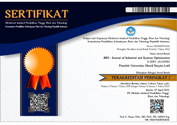PENINGKATAN KUALITAS PRODUKSI KAYU DOWEL SAPU DENGAN PENDEKATAN METODE SEVEN TOOLS DAN 5W + 1H
DOI:
https://doi.org/10.51804/jiso.v5i1.39-46Keywords:
peningkatan kualitas, seven tools, 5 w 1 hAbstract
Masyarakat pasti memerlukan alat kebersihan berupa sapu. Pegangan sapu umumnya menggunakan bahan dari kayu. Penggunaan material kayu berupa dowel mempunyai beberapa keunggulan yaitu ringan, tidak selip, ramah lingkungan dan murah. Untuk menghadapi persaingan global yang semakin ketat, CV. Yu Jaya Bersama perlu melakukan peningkatan kualitas terhadap produk kayu dowel sapu yang diproduksinya. Penurunan kualitas produksi terjadi karena banyaknya terjadi cacat produk. Metode Seven Tools diharapkan dapat mengetahui sebab dan akibat permasalahan yang terjadi dalam usaha pengendalian kualitas produksi kayu dowel sapu. Selanjutnya dengan metode 5W+1H dapat memberikan usulan perbaikan kualitas dengan memprioritaskan pada penyebab cacat yang paling dominan. Dari analisis Seven Tools diketahui bahwa faktor penyebab kegagalan pengolahan kayu dowel diameter 22 mm panjang 90 cm adalah dari kualitas bahan baku yang digunakan serta sumber daya manusia yang kurang terampil dan terlatih. Cacat produk yang paling dominan adalah cacat patah kayu yang mencapai 49,135% dari keseluruhan total jenis cacat. Usulan perbaikan dengan metode 5W+1H adalah dengan mengunakan material kayu kualitas mahoni prima (grade A), ketrampilan asah pisau dan setting roll terhadap bagian mekanik harus ditingkatkan. Selain itu perlu adanya training untuk karyawan saat awal pemilihan sortir bahan dan proses mesin dowel agar lebih terampil, teliti dan terlatih dalam mengerjakan pekerjaannya.
ABSTRACT
People definitely need a cleaning tool in the form of a broom. The broom handle generally uses wood. The use of wood material in the form of dowels has several advantages, namely lightweight, non-slip, environmentally friendly and inexpensive. To face the increasingly fierce global competition, CV. Yu Jaya Bersama needs to improve the quality of the dowel broom wood products it produces. The decline in production quality occurs due to the number of product defects. The Seven Tools method is expected to be able to find out the causes and effects of problems that occur in an effort to control the quality of dowel broom wood production. Furthermore, the 5W+1H method can provide quality improvement proposals by prioritizing the most dominant causes of defects. From the analysis of Seven Tools, it is known that the factors causing the failure to process dowel wood with a diameter of 22 mm and a length of 90 cm are the quality of the raw materials used and the lack of skilled and trained human resources. The most dominant product defects were wood fractures, which accounted for 49.135% of the total types of defects. The proposed improvement with the 5W+1H method is to use prime quality mahogany wood (grade A). Knife sharpening skills and roll settings for mechanical parts must be improved. In addition, there is a need for training for employees at the beginning of the selection of sorting materials and the dowel machine process so that they are more skilled, thorough and trained in doing their jobs.
References
Abdillah, A. (2016). Penerapan Six Sigma Dalam Pengendalian Kualitas Produk Pada Industri Pengolahan Kayu (Studi Kasus: PD. Wonoagung Sejahtera, Kabupaten Gresik) (Doctoral dissertation, Universitas Brawijaya).
Bakar, E. S., Massijaya, M., & Rachman, O. Perbaikan Kualitas Kayu Sawit (Elaeis guineensis Jacq) dengan Teknik" KomPress".
Devani, V., & Oktaviany, M. (2021). Usulan Peningkatan Kualitas Pulp Dengan Menggunakan Metode Seven Tools Dan New Seven Tools Di Pt. Ik. Agrointek: Jurnal Teknologi Industri Pertanian, 15(2), 521-536.
Kotler, P. J. (2007). Marketing management, de essentie, 3/e. Pearson Education.
Hidayat, R. (2012). Perbaikan kualitas sifat mekanis jenis kayu cepat tumbuh Jabon [Anthocephalus cadamba (Roxb.) Miq.] dengan metode pemadatan.
Hillaryus, D. (2021). Usulan perbaikan kualitas produk pintu kayu louver door dengan menggunakan Multy Attribute Failure Mode Analytic dan Fault Tree Analysis di PT. Arus Jati Indo. SKRIPSI-2021.
Idris, I., Sari, R. A., Wulandari, W., & Wulandari, U. (2018). Pengendalian Kualitas Tempe Dengan Metode Seven Tools. Jurnal Teknovasi: Jurnal Teknik dan Inovasi, 3(1), 66-80.
Muzakir, M. (2016). Analisis Usulan Perbaikan Mutu Produk Berdasarkan metode Seven Tools Di Pt. X. Jurnal Optimalisasi, 2(2).
Pane, E. P. (2019). Perbaikan Kualitas Produk Kayu Menggunakan Metode Quality Function Deployment (QFD) dan Analytical Network Process (ANP) pada PT. Sumber Karindo Sakti.
Rafli, R., Kostituante, & Yahya, I. (2021). Rancang Bangun Mesin Dowel Gagang Sapu Diameter 20 Milimeter Menggunakan Motor Bensin 7.0 Hp Sebagai Penggerak. Jurnal Teknik Mesin, 7(2), 27–33.
Rahayu, P., & Bernik, M. (2020). Peningkatan Pengendalian Kualitas Produk Roti dengan Metode Six Sigma Menggunakan New & Old 7 Tools. Jurnal Bisnis dan Kewirausahaan, 16(2), 128-136.
Ratnadi, R., & Suprianto, E. (2016). Pengendalian Kualitas Produksi Menggunakan Alat Bantu Statistik (Seven Tools) Dalam Upaya Menekan Tingkat Kerusakan Produk. Jurnal Industri Elektro dan Penerbangan, 6(2).
Samuel, R. (2020). Pengujian Tanah Ekspansif dengan Skala Model Menggunakan Kayu Dowel Sebagai Pengganti Dinding Penahan Tanah (Doctoral dissertation, Universitas Tarumanagara).
Supriyadi, A., Harmanto, S., & Kodir, M. A. (2018). IbM Klaster Industri Kecil Kerajinan Mainan dari Bahan Kayu di Klaten. Jurnal DIANMAS, 7(1).
Suryani, L. (2015). Analisis dan peningkatan kualitas sistem informasi dengan menggunakan metode seven tools dan quality function deployment (QFD) (Doctoral dissertation, Institut Teknologi Sepuluh Nopember).
Tjiptono, F., & Diana, A. (2003). Total Quality Management Edisi Revisi. Yogyakarta: Andi.
Windarti, T. (2014). Pengendalian kualitas untuk meminimasi produk cacat pada proses produksi besi beton. J@ Ti Undip: Jurnal Teknik Industri, 9(3), 173-180.
Zakariya, Y., Mu’tamar, M. F. F., & Hidayat, K. (2020). Analisis Pengendalian Mutu Produk Air Minum dalam Kemasan Menggunakan Metode New Seven Tools (Studi Kasus di PT. DEA). Rekayasa, 13(2), 97-102.
Downloads
Published
Issue
Section
License
With the receipt of the article by JISO Editorial Board and the decision to be published, the copyright regarding the article will be transferred to JISO. The copyright transfer form can be downloaded here.
JISO has the right to multiply and distribute the article and every author is not allowed to publish the same article that was published in this journal.
JISO is licensed under a Creative Commons Attribution-ShareAlike 4.0 International License.
Under the following terms:
Attribution — You must give appropriate credit, provide a link to the license, and indicate if changes were made. You may do so in any reasonable manner, but not in any way that suggests the licensor endorses you or your use.
ShareAlike — If you remix, transform, or build upon the material, you must distribute your contributions under the same license as the original.














